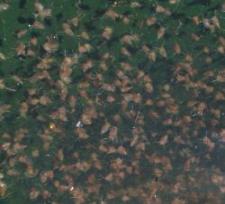| Back to Back Issues Page |
 |
|
The Goldfish Gazette, Issue #018 -- Daphnia Cultures June 28, 2015 |
Goldfish Care Tips and GuidelinesA Free Monthly Resource For Goldfish Enthusiasts In This Issue
Daphnia sources in the wild are few and far between these days. If you are lucky enough to find a supply, they tend to be there one day and gone the next. Success With Daphnia Cultures
When selling off excess fry, discussion often turns to what I feed the fry. When I explain that I feed live daphnia after brine shrimp, many of the customers say they have tried to raise them but with no success. How To Keep A Daphnia Culture AliveI was also unsuccessful for many years until I discovered where I was making some critical errors: 1. I assumed daphnia only eat green water and bacteria 2. I thought the greener their water the better 3. I thought topping up their water with tap water was OK 4. I was overfeeding. With a little research I discovered daphnia will eat a variety of foods, activated bakers' yeast and various flours being options to green water. Pea soup green water will kill daphnia. If daphnia have any difficulty swimming in green water, it is too thick and they will quickly die. It is better to add very green water to their container in small amounts. Don’t top up their water directly from the tap. Even in small amounts, water containing chlorine causes massive die offs. Treat the water for daphnia in the same way you would for any fish. How To Feed DaphniaDaphnia need very little food.Most beginners over feed the daphnia causing the water conditions to turn toxic. I usually start with aged water in a pond that has been sitting in sunlight for a week or two. A handful of dead plant material speeds up the conditioning process. When the water starts to go slightly green, I introduce the daphnia (after testing that they can easily swim in it). Depending on introduced numbers, the water will start to clear within a few days or weeks, and you will see a swarm of daphnia hopping around. This is the time you need to start feeding them. I get a glass of warm water and put in 50/50 of activated bakers' yeast and soy flower. I use a battery driven cocktail whisk and stir up the contents until there are no lumps in the mixture. Food QuantitiesJudging the correct amount of food to feed the daphnia comes with practice. Once numbers are reaching their maximum level, the culture is able to withstand a bit of overfeeding. The idea behind seeding a container that has green water in it is because you will get reasonable numbers of daphnia before you have to start feeding them. The danger period is when there are low numbers of daphnia and you have to guess how much food is needed. A good idea is to test the water daily with a water test kit until the culture is established, and then test less frequently depending on the season. For my own cultures that are cultured in 96 US gallon (80 Imp gallon or 360 liter) ponds, I use 1.5 grams of yeast and 1.5 grams of soy flower for an established culture. I feed this daily until late autumn when, depending on temperature, I will feed every second or third day until mid to late spring. You will need to calculate what quantities you need based on your container size. To read more about how to culture daphnia click here... Comments? Ideas? Feedback? I'd love to hear from you. Just reply to this e-zine and tell me what you think, or what topics you want covered. Next Month's Topic Goldfish Compatibilitywww.facebook.com/aboutgoldfish |
| Back to Back Issues Page |